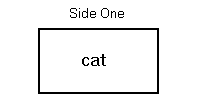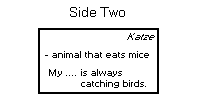Vocabulary Cards
Introduction
An excellent way to learn new words is to use vocabulary cards. Paul Nation, one of the most renowned researchers in the field of vocabulary learning, states:
"There is a very large number of studies showing the effectiveness of such learning (i.e. using vocabulary cards) in terms of the amount and speed of learning."
The diagrams below show an vocabulary card example using the word cat:


How to make and use vocabulary cards
Write the word you want to learn on the front of the card (e.g. size A7 or A8).
On the back of the card, write either the translation of the word in your language, or a definition of the word, or a gap sentence. If you write two or all three of these you will learn the word more quickly, and give yourself extra English practice.
You could of course copy the definition and example sentence from the web page, but writing your own is the better choice.
If you write down a verb, it's best to put its infinitive form. So for example it's better to write to purchase than purchased or to strike than struck.
Now imagine you have a stack of 20 words that you want to learn. To do this, you can test yourself in many different ways. For example, you can look at the word and try to remember the translation or definition.
You can look at the gap sentence and try to think of the word that fits in it. You can look at the word in your language and see if you know the English.
If you get the answer right, write a tick in the left corner on side one of the card, put the card at the back of your To learn stack, and take the next card. If you get it wrong, write a cross and put the card ten places from the front of your stack.
When you have three ticks in a row on your card, you know the word and can put the card into a second stack, called the Done stack. You should try and look at about 10-20 words each week in your To learn stack.
And every few months you can look at some of the cards in your Done stack, just to make sure you haven't forgotten them. If you have, then you can return the cards to the To learn stack and start the process again.
An alternative to flashcards
An excellent modern alternative to physical flashcards is digital cards. Digital apps such as Anki and Quizlet are popular examples.
This site has its own digital flashcard alternative, namely a spaced-repetition app. The starting page of the app has a link to information about the spaced-repetition learning methodology.
Reference
- Nation, P. Vocabulary size, text coverage and word lists ". In: Schmitt, N. & McCarthy, M. (eds.) Vocabulary: Description, Acquisition and Pedagogy. Cambridge University Press. 1997.)